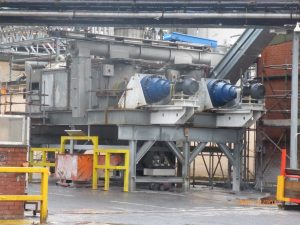May 18, 2020
It was three years ago that Vincent went through the most expensive warranty experience in the history of the company. It occurred at the SCA Stubbins tissue mill in Ramsbottom, England.
The application seemed ordinary enough: take wastewater treatment sludge and squeeze it as it comes off a group of belt presses at a paper mill. The unusual requirement was that the cake must have extraordinary dryness. The project justification was based converting the sludge into bedding for dairy farms.
Initial testing with a laboratory CP-4 screw press looked promising. Because of the size and scope of the project, a Vincent field engineer traveled to the job site to perform the testing a second time.
It was calculated that a pair of Model VP-24 presses would be required. Fortunately the project went ahead shortly after Vincent had acquired six surplus Model VP-30 presses. The owner elected to buy two of these larger presses.
During start-up, two problems became apparent. The presses were not able to consistently remove sufficient moisture to produce cake with 57% solids, and the presses overloaded and tripped out when full plant load was fed to the machines.
The first step, in order to achieve tighter squeezing and drier press cake, was to increase the diameter of the screw shaft close to the cake discharge. Our welder did that by welding 2-1/2″ flat bar ribs to that portion of the shaft. The effect was to force the sludge through a smaller opening.
The modification was successful in causing the sludge to be squeezed tighter. It resulted in adequate moisture removal. However that only made the electrical overloading more severe.
First we went from the original 50 hp 1500 rpm motors (10 screw rpm) to 50 hp 1000 rpm motors (7 screw rpm). That gave us a third again the torque. Next we replaced those motors with 60 hp 750 rpm motors (5 screw rpm). That was still not enough torque, so we converted the drive from direct coupled motors to belt driven. The belt drives gave us room to use 75 hp 1500 rpm motors (3 screw rpm). Vincent paid for the larger VFD’s which were required, and with the belt drives we got the torque up to where the presses could be kept in service.
Probably the most important technical advance from all of this was working out a simple device for limiting the power to the maximum allowed by the motor. In operation the amps drawn by the motor would creep up until the motor would trip out. We knew that the amp-creep could be halted by opening the discharge cone for a few seconds. To automate this we used a Red Lion programmable relay working with an amp sensor and a solenoid operated air valve. The relay was programmed to open the cone’s air valve at a set point near FLA (Full Load Amps). It was also programmed to close the cone once the amps had dropped a few points below FLA. This kept the press operating continuously in a range near its full power potential. With this addition, the cone cycled open and closed at intervals from every fifteen seconds to three minutes. Since working out the details, this system has been retrofitted to other Vincent installations.
The presses are mounted in parallel, and the first press tended to take too much of the flow, so it overloaded. That made it necessary to limit the flow of material going into that first press. There was no room to install a rotary feeder (star valve) over the inlet to the press. So instead the diameter of the screw shaft was increased in the inlet of the press. This was done by welding pieces of flat bar to the shaft of the screw. The welding was all done up-side-down, with our welder wedged in the pan under the screw, covered with fireproof blankets. The modification successfully limited the amount of sludge which was being fed into that press.
Here’s where it really got expensive. With the 75 hp motor driving the screw at only 3.1 rpm, the gearbox was tremendously and severely overloaded. The torque was triple what we had started with. We asked only that the gearbox last for the three months it would take to have replacement gearboxes manufactured. Sumitomo field engineers helped at the site, without charge. It is amazing that these Sumitomo parallel shaft gearboxes held up without a hitch.
The replacement gearboxes selected were Rossi planetary units. We selected a very high reduction ratio, allowing 60 hp motors to be direct coupled to the gearbox (that took the screw rpm down to 1.7). That required extending the frames of the presses by ten feet!
These changes finally allowed the system to operate as required.
ISSUE #321

